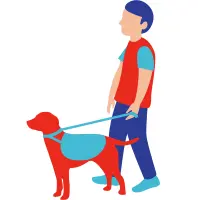1. Possessive pronouns table

2. What are possessive pronouns?
Possessive pronouns are pronouns that indicate ownership or the relationships to objects or person. There are six possessive pronouns in English: mine, yours, his, hers, ours, and theirs. But what about its? Its is commonly used as a possessive determiner (its paw, its leaves, its tyre etc.) or possessive adjective rather than a possessive pronoun.

I think this pen is mine.

Are these books yours?

The dog is his

The dog is hers.

The Earth is ours.

The dog is theirs.
3. Possessive pronouns vs possessive adjectives
Possessive adjectives must be used before nouns (my job, your computer, his wife, her husband, its food, their cars). However, possessive pronouns can be used on their own. When do we use them? We use possessive adjectives when we need to define who owns something directly before a noun.
Example:
● I can’t find my keys.
We use possessive pronouns when we want to avoid repeating the noun that indicate ownerships.
● Is this book your book? → Is this book yours?
4. How to use possessive pronouns in sentences?
4.1 Replacing a noun to avoid repetition
Possessive pronouns are particularly useful for avoiding redundancy in conversation and writing as illustrated in the table below.
| Possessive pronouns | Sentences with repetition | Sentences without repetition |
|---|---|---|
| mine | This phone is my phone. | This phone is mine. |
| This phone belongs to me. | ||
| Yours | Is this laptop your laptop? | Is this laptop yours? |
| The responsibility is your responsibility. | The responsibility is yours. | |
| His | (Is that Mark’s computer?) Yes, that is Mark's computer. | (Is that Mark’s computer?) Yes, that is his. |
| I lost my wallet yesterday. My brother lost my brother’s wallet too. | I lost my wallet yesterday. My brother lost his too. | |
| Hers | No, the final decision was her final decision. | No, the final decision was hers. |
| The mistake made in the report was not her mistake. | The mistake made in the report was not hers. | |
| Ours | This house is the house that belongs to us. | This house is ours. |
| Some of these paintings are not our paintings. | Some of these paintings are not ours. | |
| Yours (plural) | Are all these paintings the paintings that belong to the two of you? | Are all these paintings yours? |
| These books are mine. Your book and your brother’s book are over there. | These books are mine. Yours are over there. | |
| Theirs | Mr Mark and his associates bought this bank a few years ago. It belongs to Mr Mark and his associates now. | Mr Mark and his associates bought this bank several years ago. It is theirs now. |
| My friends have beautiful cars. I want a car like the car of my friends. | My friends have beautiful cars. I want a car like theirs. |
4.2 Responding to questions about ownership
Possessive pronouns are often used to answer questions about who something belongs to. Study the examples below.
- Whose phone is this? – It’s hers.
- Is this your coffee? – No, it’s his.
- Is this your computer? – Yes, it’s mine.
- Are these your tickets? – No, they are theirs.
4.3 Emphasising possession while comparing things
You can use possessive pronouns to make comparisons more concise and impactful.
- Their house is bigger than ours.
- His performance was good, but hers was outstanding.
- Your recipe is delicious, but hers is simply unbeatable.
4.4 Usage tips
Ensure that the noun being replaced is clear from the context, as possessive pronouns do not include the noun themselves. The listener or the reader should be able to guess who or what are you referring to. Study the examples below.
Situation 1: Two friends are talking about cars.
- Friend 1: I saw that you bought a new car. It looks great!
- Friend 2: Thanks! What about you? Are you still using the old one?
- Friend 1: No, I upgraded last month. It's the red one parked outside, next to yours.
In this example, the use of yours correctly replaces "car", which is clearly understood from the ongoing conversation about cars. The clarity of the previous statements ensures that the listener knows exactly what yours refers to. Now let's study the example below where the situation is ambiguous.
Situation 2: A lady walked into a room where various items like a book, a laptop, and a backpack are on a table. As she entered the room, she said "That’s mine." For this scenario, the use of mine is problematic because it's unclear which item the speaker is referring too. Without specifying or having a clear, previously established context, the listeners are left unsure whether the speaker is referring to the book, the laptop, the backpack, or something else entirely.
5. Common mistakes
5.1 Confusing possessive pronouns with possessive adjectives
A frequent error is using a possessive adjective where a possessive pronoun is needed, and vice versa. For example, saying "This is hers book." when it should be "This book is hers." Remember that a possessive adjective is always preceded by a noun, while a possessive pronoun is not.
5.2 Using an apostrophe
Possessive pronouns do not require apostrophes. A common mistake is adding an apostrophe as in "her's" or "our's."
5.3 Mixing up "its" and "it's"
"Its" is a possessive determiner, while "it's" is a contraction for "it is" or "it has." It is always preceded by a noun.
- The company changed its policy. Correct.
- The company changed it's policy. Incorrect.
- My dog lost its toy (Correct). Yours lost its, too (Incorrect since the determiner its must be preceded by a noun).
